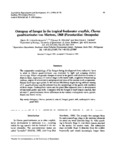Ontogeny of foregut in the tropical freshwater crayfish, Cherax quadricarinatus von Martens, 1868 (Parastacidae: Decapoda)
- Global styles
- MLA
- Vancouver
- Elsevier - Harvard
- APA
- Help

View/
Date
1994Page views
1,444ASFA keyword
AGROVOC keyword
Metadata
Perlihat publikasi penuhCited times in Scopus
Share
Abstract
The comparative morphology of the foregut during development from embryonic larva to adult in Cherux quadricarinatus was examined by light and scanning electron microscopy. Major ontogenetic changes occurred in the gastric mill dentition in terms of denticle shape, appearance of vertical ridges in the lateral teeth, roughness of masticating surfaces, degree of sclerotization and proportional sizes of the median tooth components. Natural food types appropriate for the various life history stages during artificial rearing of C. quadricarinatus may be inferred from the morphology of the gastric mill dentition of those stages. Cardiopyloric valves and the gland filter appeared prior to development of functional gastric mill teeth. Compared with the foregut of adult astacid crayfish, that of adult C. quadricarinatus shows differences in the ventral cardiopyloric valve, pyloric funnel and lateral valves.
Suggested Citation
Loya-Javellana, G. N., Fielder, D. R., & Thorne, M. J. (1994). Ontogeny of foregut in the tropical freshwater crayfish, Cherax quadricarinatus von Martens, 1868 (Parastacidae: Decapoda). Invertebrate Reproduction and Development , 25(1), 49-58. https://doi.org/10.1080/07924259.1994.9672368
Type
ArticleISSN
0792-4259Koleksi
- Journal Articles [1232]

